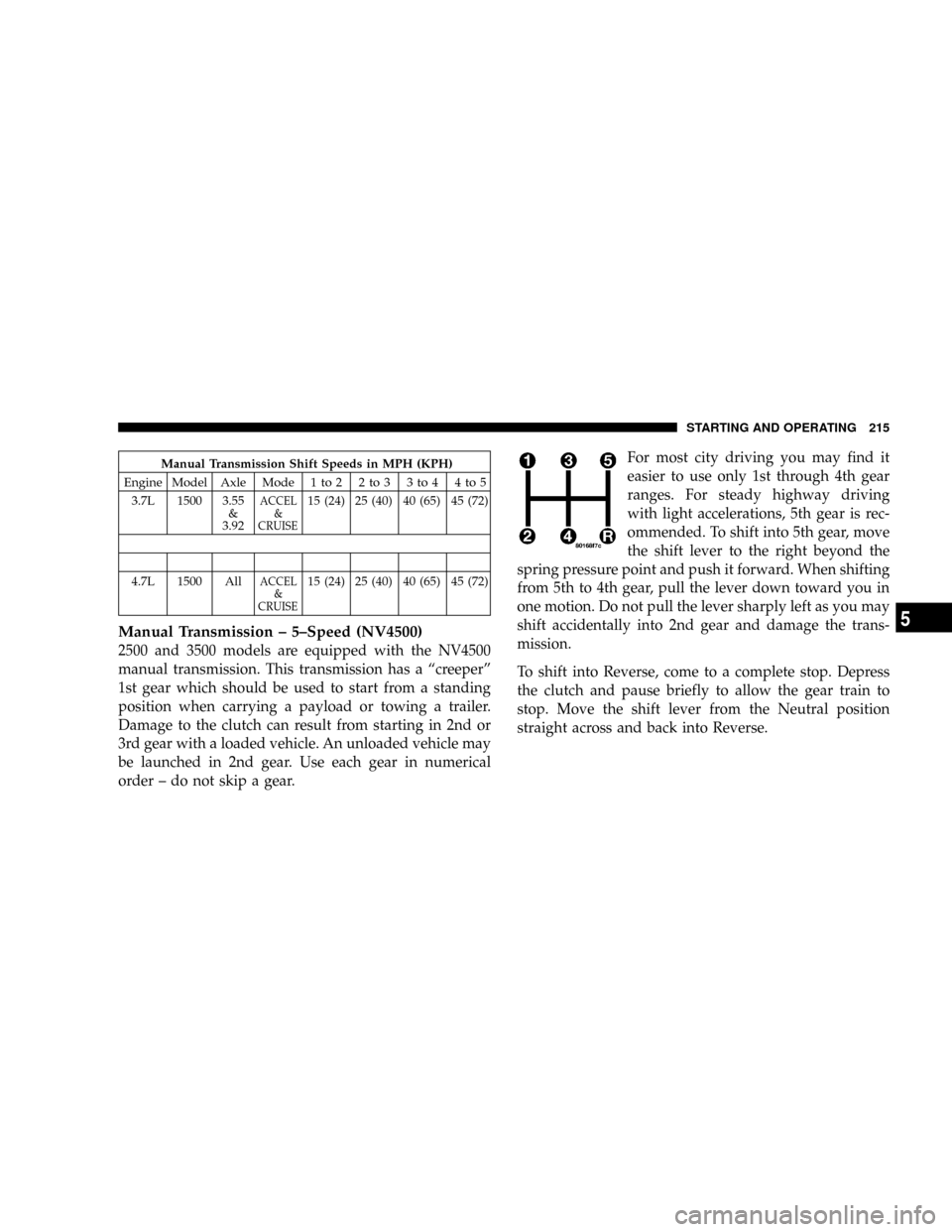Page 208 of 429

CAUTION!
Long periods of engine idling, especially at high
engine speeds can cause excessive exhaust tempera-
tures which can damage your vehicle. Do not leave
your vehicle unattended with the engine running.
WARNING!
Do not leave children or animals inside parked
vehicles in hot weather. Interior heat build up may
cause serious injury or death.
TRANSMISSION SHIFTING
Automatic Transmission with Overdrive
The gear shift selector display, located in the instrument
panel cluster, indicates the transmission gear range (the
selector is illuminated for night driving). The selector
lever is mounted on the right side of the steering column.
You must depress the brake pedal, to pull the selector
lever out of park (P) position (Brake Interlock System). To
drive, move the selector lever from Park or Neutral to the
desired drive position. Pull the selector lever toward you
when shifting into Reverse, Second, First or Park, or
when shifting out of Park.
Gear Ranges
DO NOT race the engine when shifting from Park or
Neutral position into another gear range.
ªPº Park
This gear position supplements the parking brake by
locking the transmission. The engine can be started in
208 STARTING AND OPERATING
Page 211 of 429

Overdrive Operation
The overdrive automatic transmission contains an elec-
tronically controlled fourth and fifth (if equipped) speed
(Overdrive). The transmission will automatically shift
from Drive to Overdrive if the following conditions are
present:
²the transmission selector is in Drive;
²the engine coolant has reached normal operating tem-
perature;
²vehicle speed is above approximately 30 mph (48
km/h);
²the ªTOW/HAULº switch has not been activated;
²transmission has reached normal operating tempera-
ture.
NOTE:If the vehicle is started in extremely cold tem-
peratures, the transmission may not shift into Overdriveand will automatically select the most desirable gear for
operation at this temperature. Normal operation will
resume when the transmission fluid temperature has
risen to a suitable level. Refer also to the Note under
torque converter clutch, later in this section.
If the transmission temperature gets extremely hot, the
transmission will automatically select the most desirable
gear for operation at this temperature. If the transmission
temperature becomes hot enough the TRANS TEMP light
may illuminate and the transmission may downshift out
of Overdrive until the transmission cools down. After
cooldown, the transmission will resume normal opera-
tion.
The transmission will downshift from Overdrive to Drive
if the accelerator pedal is fully depressed at vehicle
speeds above approximately 35 mph (56 km/h).
STARTING AND OPERATING 211
5
Page 212 of 429

When To Use ªTOW/HAULº Mode
When driving in hilly areas, towing a trailer, carrying a
heavy load, etc., and frequent transmission shifting oc-
curs, press the ªTOW/HAULº button. This will improve
performance and reduce the potential for transmission
overheating or failure due to excessive shifting. When
operating in ªTOW/HAULº mode, 5th gear (ifequipped) is disabled and 2-3 and 3-4 shift patterns are
modified. Shifts into Overdrive (4th gear) are allowed
during steady cruise (for improved fuel economy) and
automatic closed-throttle downshifts to 3rd gear (for
improved braking) will occur during steady braking.
The ªTOW/HAULº light will illuminate in the instru-
ment cluster to indicate when the switch has been
activated. Pressing the switch a second time restores
normal operation. If the ªTOW/HAULº mode is desired,
the button must be pressed each time the engine is
started.
Torque Converter Clutch
A feature, designed to improve fuel economy, has been
included in the automatic transmission on your vehicle.
A clutch within the torque converter engages automati-
cally at calibrated speeds. This may result in a slightly
different feeling or response during normal operation in
212 STARTING AND OPERATING
Page 213 of 429

high gear. When the vehicle speed drops or during
acceleration when the transmission downshifts to second
gear, the clutch automatically disengages.
NOTE:The torque converter clutch will not engage
until the transmission fluid and engine coolant are warm
[usually after 1-3 miles (1.6 - 4.8 km) of driving]. Because
the engine speed is higher when the torque converter
clutch is not engaged, it may seem as if the transmission
is not shifting into Overdrive when cold. This is normal.
Pressing the ªTOW/HAULº button, when the transmis-
sion is sufficiently warm, will demonstrate that the
transmission is able to shift into and out of overdrive.
NOTE:If the vehicle has not been driven in several
days, the first few seconds of operation after shifting the
transmission into gear may seem sluggish. This is due tothe fluid partially draining from the torque converter into
the transmission. This condition is normal and will not
cause damage to the transmission. The torque converter
will refill within five seconds of shifting from Park into
any other gear position.
Manual Transmission Ð 5-Speed
NOTE:The parking brake should be engaged before
leaving the vehicle, especially on an incline.
Truck models with manual transmission are equipped
with a clutch interlocking ignition system. The clutch
pedal must be fully depressed to start the vehicle.
Fully depress the clutch pedal before shifting gears. As
you release the clutch pedal, lightly depress the accelera-
tor pedal.
STARTING AND OPERATING 213
5
Page 214 of 429

Manual Transmission Ð 5±Speed (NV3500)
1500 models are equipped with the NV3500 manual
transmission. Be sure the transmission is in 1st gear when
starting from a standing position. Damage to the clutch
can result from starting in 2nd or 3rd gear. Use each gear
in numerical order ± do not skip a gear.
For most city driving you may find it
easier to use only 1st through 4th gear
ranges. For steady highway driving
with light accelerations, 5th gear is rec-
ommended. To shift into 5th gear, move
the shift lever to the right beyond the
spring pressure point and push it forward. When shifting
from 5th to 4th gear, pull the lever down toward you in
one motion. Do not pull the lever sharply left as you may
shift accidentally into 2nd gear and damage the trans-
mission.To shift into Reverse, come to a complete stop. Depress
the clutch and pause briefly to allow the gear train to
stop. Move the shift lever from the Neutral position
straight across and back into Reverse.
Never drive with your foot resting on the clutch pedal, or
attempt to hold the vehicle on a hill with the clutch pedal
partially engaged, as this will cause abnormal wear on
the clutch.
Recommended Vehicle Shift Speeds
To utilize your manual transmission efficiently for both
fuel economy and performance, it should be upshifted as
listed in the following chart. Shift at the vehicle speeds
listed for acceleration. Earlier upshifts during cruise
conditions (steady speeds) will result in increased fuel
economy, and may be used as indicated.
214 STARTING AND OPERATING
Page 215 of 429

Manual Transmission Shift Speeds in MPH (KPH)
Engine Model Axle Mode 1 to 2 2 to 3 3 to 4 4 to 5
3.7L 1500 3.55
&
3.92
ACCEL
&
CRUISE15 (24) 25 (40) 40 (65) 45 (72)
4.7L 1500 All
ACCEL
&
CRUISE15 (24) 25 (40) 40 (65) 45 (72)
Manual Transmission ± 5±Speed (NV4500)
2500 and 3500 models are equipped with the NV4500
manual transmission. This transmission has a ªcreeperº
1st gear which should be used to start from a standing
position when carrying a payload or towing a trailer.
Damage to the clutch can result from starting in 2nd or
3rd gear with a loaded vehicle. An unloaded vehicle may
be launched in 2nd gear. Use each gear in numerical
order ± do not skip a gear.For most city driving you may find it
easier to use only 1st through 4th gear
ranges. For steady highway driving
with light accelerations, 5th gear is rec-
ommended. To shift into 5th gear, move
the shift lever to the right beyond the
spring pressure point and push it forward. When shifting
from 5th to 4th gear, pull the lever down toward you in
one motion. Do not pull the lever sharply left as you may
shift accidentally into 2nd gear and damage the trans-
mission.
To shift into Reverse, come to a complete stop. Depress
the clutch and pause briefly to allow the gear train to
stop. Move the shift lever from the Neutral position
straight across and back into Reverse.
STARTING AND OPERATING 215
5
Page 216 of 429

Never drive with your foot resting on the clutch pedal, or
attempt to hold the vehicle on a hill with the clutch pedal
partially engaged, as this will cause abnormal wear on
the clutch.
Manual Transmission Shift Speeds
To utilize your manual transmission efficiently for both
fuel economy and performance, it should be upshifted as
listed in the following chart. Shift at the vehicle speeds
listed for acceleration. Earlier upshifts during cruise
conditions (steady speeds) will result in increased fuel
economy, and may be used as indicated.
Manual Transmission Shift Speed in mph (km/h)
EngineModel Axle Model 1 to 2 2 to 3 3 to 4 5 to 6
5.7L2500/
3500ALL
ACCEL
&
CRUISE15 (24) 25 (40) 40 (65) 45 (72)
Downshifting
Moving from a high gear down to a lower gear is
recommended to preserve brakes when driving down
steep hills. In addition, downshifting at the right time
provides better acceleration when you desire to resume
speed. For acceleration at speeds less than 20 mph (30
km/h), 2nd gear is recommended.
FOUR-WHEEL- DRIVE OPERATION Ð IF
EQUIPPED
²
Four-Wheel-Drive Dodge Ram Trucks are equipped
with either a Manually Shifted transfer case or an
Electronically Shifted transfer case. See the operating
instructions for your transfer case, located within this
section.
216 STARTING AND OPERATING
Page 218 of 429

place. Shifting while only the front or rear wheels are
spinning can cause damage to the transfer case.
Because 4-wheel drive provides improved traction, there
is a tendency to exceed safe turning and stopping speeds.
Do not go faster than road conditions permit.
NOTE:Delayed shifts out of four-wheel drive may be
experienced due to uneven tire wear, low or uneven tire
pressures, excessive vehicle loading, or cold tempera-
tures.WARNING!
You or others could be injured if you leave the
vehicle unattended with the transfer case in the
Neutral (N) position without first fully engaging the
parking brake. The transfer case Neutral (N) position
disengages both the front and rear driveshafts from
the powertrain and will allow the vehicle to move
regardless of the transmission position. The parking
brake should always be applied when the driver is
not in the vehicle.
For additional information on the appropriate use of each
transfer case mode position see the information below:
2H
Rear Wheel Drive High Range - Normal street and
highway driving. Dry hard surfaced roads.
218 STARTING AND OPERATING